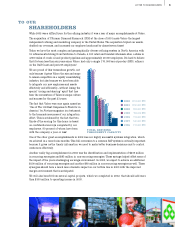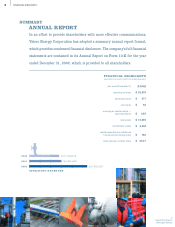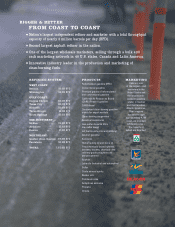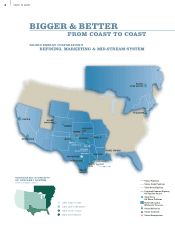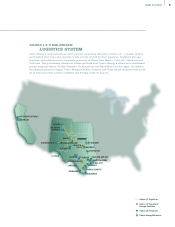Valero 2002 Annual Report Download - page 14
Download and view the complete annual report
Please find page 14 of the 2002 Valero annual report below. You can navigate through the pages in the report by either clicking on the pages listed below, or by using the keyword search tool below to find specific information within the annual report.
12 REFINERIES ACROSS NORTH AMERICA & NEARLY 2MILLION BPD OF CAPACITY
With the UDS acquisition, Valero became one of the nation’s biggest refiners with 12 refineries and a
throughput capacity of nearly 2 million barrels per day (BPD). And, bigger in this case is definitely
better because Valero achieved greater geographic diversity while maintaining its leverage to low-cost
feedstocks and premium products.
By adding refineries in locations stretching from Canada to California, Valero staked its claim as the most
geographically diverse refiner in the United States. Because margins vary at different times for different
products at different locations, having a geographically diverse refining system helped balance Valero’s
earnings. When margins were weak in one area of the system, they were often offset by stronger margins
in other areas of the network. For example, Valero’s Mid-Continent and Canadian refining systems—where
Valero previously had no presence—contributed $250 million to operating income in 2002, which
represented approximately 40 percent of the total refining contribution for the year.
And because these newly acquired
refineries were generally high-conversion
facilities, Valero’s network remained the
most complex refining system in the
United States. The majority of Valero’s
refineries are capable of processing
lower cost feedstocks, such as resid and
sour crude oil, into premium products,
such as reformulated gasoline (RFG),
low-sulfur diesel and jet fuel.
As a result, Valero’s refining system
has a complexity rating of 11.9 versus
the U.S. average of 10.4 as ranked by
the Nelson Complexity Scale.
Making these advantages all the more
powerful is the fact that Valero has
substantially more leverage to refining
margins than its nearest competitor.
For every $1.00 improvement in
margins, Valero should realize a
$4.00 increase in earnings per share.
The bottom line is being a bigger
refiner means better returns for
Valero’s shareholders.
0102030405060708090100
55%
GASOLINE & BLENDSTOCKS
30%
DISTILLATES
15%
ASPHALT, LUBES & PETROCHEMICALS
75%
of distillates
are low-sulfur.
50%
of gasoline &
blendstocks are produced
as RFG and CARB.
PRODUCT SLATE
12 OPERATIONS
0102030405060708090100
05%
OTHER FEEDSTOCKS
05%
BLENDSTOCKS
30%
SWEET CRUDE OIL
60%
SOUR FEEDSTOCKS
FEEDSTOCK SLATE
Valero’s Three Rivers Refinery
▲



